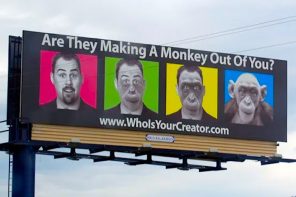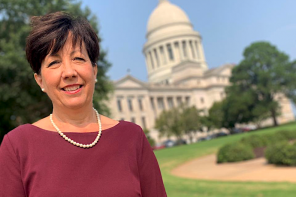The healing promise of faith—its capacity to stanch bleeding or eviscerate physical illness—appears in some of the oldest texts of Western culture. The gospel accounts attributed to Matthew, for instance, tell the story of a woman who’s been bleeding (presumably an intrauterine problem) for twelve years. She sneaks up behind Jesus, thinking that if she’s able to touch even the hem of his robe, she might be riddled with the miraculous—that her body might be healed. He senses her presence and turns around. “Take heart, daughter,” he says, directing her attention away from his garment, “your faith has healed you.” And so, we’re meant to presume, it was.
Anne Harrington, the Harvard historian of science, studies fields like neuroscience, but she takes miracle stories like this seriously. Stories, she says, “get under our skin,” almost like a virus or bacteria. She warns her undergraduate students that, in order to do well in her course, they’ll need to take reports of demonic possession seriously as well. More, she sees these miraculous accounts embedded within medical science itself. The suggestive power of healing—merely through hopeful belief—has long operated, in medicine, under the guise of the “placebo.” It is just one of what she calls the “mollifying objects” (pills, powders, tonics, tinctures) that doctors administer in order to make patients think they’re being healed.
In early November, Harrington spoke to a crowd of religion scholars in an address at the annual American Academy of Religion conference. She spoke, primarily, about the strange medical history of the placebo, pointing to laboratory studies—conducted in the 1970s—indicating that placebos might bear a genuine biochemical effect on the body. A plethora of studies done in the wake of this research, she added, suggest that healing might occur by faith in the placebo effect alone.
But, most significantly, Harrington described how the placebo effect has worked to tangle religious faith, even divinity, up in modern medicine. If the placebo can be said to “heal,” and if the placebo effect is something like a faith, a hope, or a belief, then doesn’t religious faith offer something like a turbo-charged, unadulterated placebo effect?
It was with this ideas in mind that numerous studies throughout the 1980s, 1990s, and early 2000s sought to determine whether religious practices such as prayer were healing forces whose efficacy could be verified through clinical trials and modern science. But, in 2006, the largest and most ambitious prayer study to date (led by the cardiologist Herbert Benson) indicated that patients who were prayed for (and were told about it, giving their treatment a placebo-like quality) fared just a bit worse than other patients in the trial.
Some have read this data as discrediting the efficacy of prayer. But what Harrington wants to suggest is that this study might indicate nothing more than a failure to ask the right questions of both religion and medicine.
“I thought the prayer studies were a bad idea,” Harrington told me when I visited her office at the Harvard Science Center, where her window looks out onto the Harvard Divinity School. “I can’t imagine why you would measure prayer like an anti-cholesterol drug. Researchers worried about things like ‘background prayer’ or ‘dosage.’ It was ridiculous. Prayer doesn’t come in a pill.”
If Harrington finds these studies problematic, she also believes that there’s much work to be done in investigating the “hybrid spaces” where religion and medicine meet. The quest to legitimize religious practices and beliefs by “proving” their efficacy in clinical trials and scientific studies is, she suggests, simply the wrong model.
Too many people make the assumption, Harrington says, “that what they’re going to find in the encounter between religion and science is… people fighting.” But the reality is much more complex. This is true, of course, for the high visibility debates over evolution. Sure, there are polemical debates between skeptics and believers over the truth and validity of evolutionary theory. But there are also some wild fusions of faith and science—in the guise of, say, the Intelligent Design movement—that work to recruit a specific kind of science in order to combat another.
“When you look at medicine,” says Harrington, the relationship between religion and science becomes “vastly more complicated, in part because medicine and religious faith traditions both have a claim to healing as their business. Both claim that they really heal.” What this means, effectively, is that religion and medicine (if they’re not at “loggerheads”) are going to “do business with each other.” That is, they’ll be engaged in forms of exchange and commerce.
Often, religion and medicine are obligated to do business by the patient herself. Patients, who walk into a doctor’s office with concrete religious practices habituated into their daily lives, with myths and stories crawling under their skin, bring religion and medicine together whether these disparate disciplines want them to or not. Patients have been the primary cause of what Harrington calls medicine’s “imperfectly secularized” nature.
Sometimes, it’s true, medicine has absolutely nothing to do with religion, or faith. “Medicine is most secular when it’s most effective,” Harrington told me. “I’ve never quite put it that way before. But I do think that when it can intervene in an acute and efficacious way, you don’t need to bring in the big questions.”
A broken leg, orthopedics, dentistry: these might all be prime examples of highly secular forms of medicine. “But where medicine’s knowledge is imperfect in its capacity to intervene, and diseases become chronic, and questions arise like ‘What’s the rest of my life going to be like?’ you want to know, when you go see your doctor, that you’re more than just the sum of your tumors,” says Harrington. “You’re going to be thinking about your family, your time, your pain. People seek help or hope that can’t be packaged into a medication or a physical treatment.”
Some movements, such as Hospice care, have gone a long way toward fusing the spiritual and the medical in patient care. But Harrington intimates that the “mind,” “soul,” or “spirit” factor needs to become a more integral part of how we—as a culture—understand healing practices at large.
She even goes so far as to say that religion (broadly interpreted) is what drove her interest in the history of science to begin with. She started out as an historian of the brain. But, she says, “I’d become persuaded that—particularly when it came to human beings—the sciences had turned us into a bag of chemicals, a set of physiological processes. They presented a very depressing—existentially depressing—vision of what it means to be human.”
She found a kind of hope in concepts such as “mind” that resisted the aggressive materialization of bodies at work in much of contemporary science. “I think we experience ourselves as spheres of awareness who aspire for infinity, or some kind of meaning. And I think that this is either absent, or grossly distorted in most contemporary scientific conversations about human beings,” she says. “So I have a kind of protectiveness over this reality of our humanness, and I do a certain kind of historical work that tries to demonstrate its power and importance.”
Of course, this doesn’t mean she believes religion and medicine should always “do business” together; she sees value in their existence as disparate spheres. Harrington is interested in the “hybrid spaces” where religion and science meet, “but in no way do I think things should get mushy.” There really is, she argues, “a place for data. And I think modern science should stay in the business of being evidence-based. But I don’t think that every other healing community in the world should be building itself along the lines of that model. There’s a place for data, but you need to know what data can’t tell you.”
How might those of us interested in religion begin to investigate the messy, tangled, hybrid space where faith healing meets clinical healing, then? What about, Harrington suggests, thinking of the medical office, or the surgical table, as itself a kind of “sacramental space”? This might illuminate what Harrington calls the “powerful ritual nature” of modern medicine that may—perhaps—have as much to do with the healing of some illnesses as the pill itself.
“You have the ritual of the medical encounter, the authority of a doctor, the props of healing that have efficacious pharmaceutical properties, but which also convey the hopes that we put into modern biomedical research.” To read ritual into, or onto, modern medicine—to ghost medicine with the hallowed—is not to suggest that medicine is merely a ritual of healing but perhaps, Harrington might say, “it is also a ritual of healing.”




